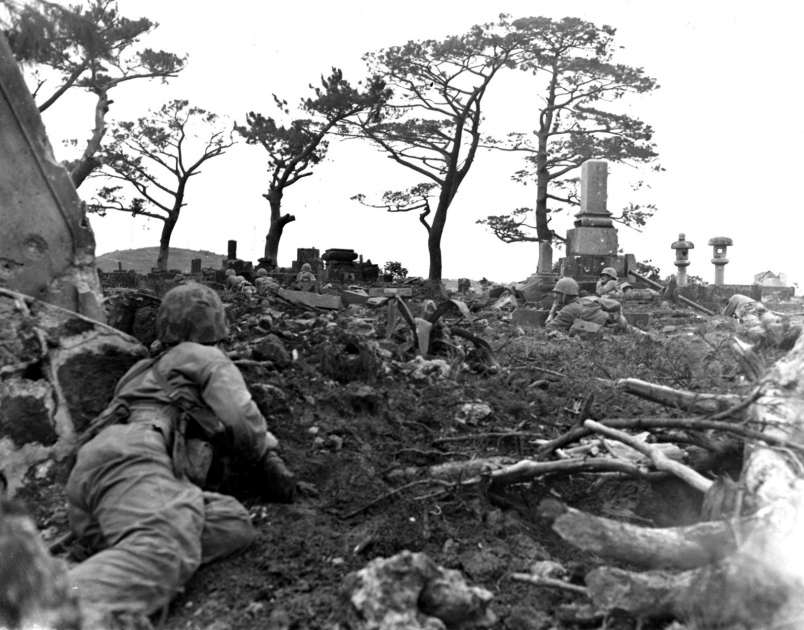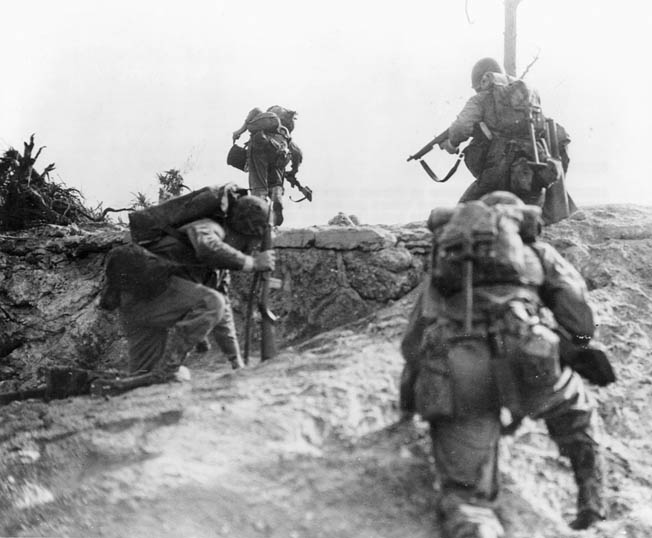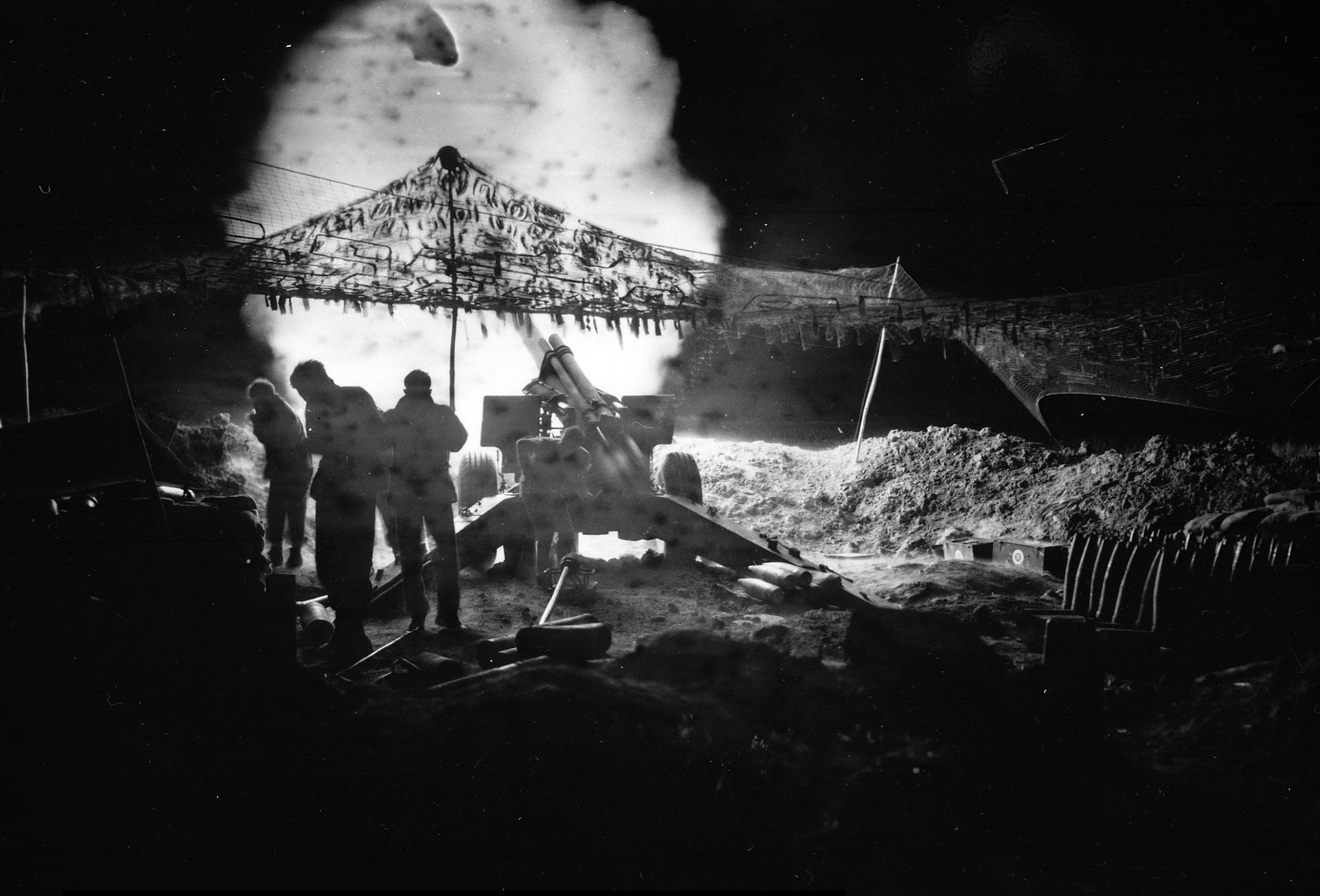 May 1-9 1945 – Training to Fighting
May 1-9 1945 – Training to Fighting
The names of Kakazu Ridge, Tombstone Ridge, Tabletop, Gate, Needle Rock, Hill 153, Big Escarpment had now become a legend as the battle-weary doughboys came out of the lines for a much needed and deserved rest. For 30 days these men had fought and defeated a stubborn and smart enemy in some of the bloodiest fightings yet encountered in Pacific warfare. Battle casualties had been high. During the month of April, the division had suffered 565 KIA, and 2771 WIA and now the infantry regiments were only 52% combat efficient based on the T/O strength. During the first nine days of May, the 96-ID entered into a reorganization and training period. By May 8, over 4000 infantry replacements had joined the division and began intensive training in scouting and patrolling, marksmanship, and known distance firing. As part of this training program, the replacements patrolled bypassed pockets of enemy resistance within the rear areas. As these patrols combed the area, numerous Japs were killed and US and enemy equipment was recovered. The maintenance of vehicles, guns, personal arms, and equipment was stressed and Ordnance inspections were held by all units of the Division. Much time was devoted to rest and recreation for the troops as they came out of the line. Red Cross and Special Service Officers initiated the preparation of recreation camps for all types of sports such as baseball, football, and volleyball.
 The 96-ID Band provided musical entertainment and extensive use was made of PA (Public Addressing) systems bringing radio and transcribed programs to the troops. The Red Cross made available tons of supplies such as magazines, books, games, writing materials, and toilet articles. The Special Service Office provided many late movies. The movie ‘Wilson’ was shown for the first time on the island to the men of the 383-IR. Approximately nine enemy air-raid alerts took place during the showing of the picture and each time the men would head for their holes and when the all-clear was sounded they would return. It took most of the night to complete the movie but every man stayed until the end. The 383rd Infantry Regiment was, in the paper, in reserve for the 77th Infantry Division during this reorganization and training period but was not committed. However, the 96th Infantry Division Artillery remained in position and continued to reinforce the fires of the 77th Infantry Division Artillery under the XXIV Corps Artillery control.
The 96-ID Band provided musical entertainment and extensive use was made of PA (Public Addressing) systems bringing radio and transcribed programs to the troops. The Red Cross made available tons of supplies such as magazines, books, games, writing materials, and toilet articles. The Special Service Office provided many late movies. The movie ‘Wilson’ was shown for the first time on the island to the men of the 383-IR. Approximately nine enemy air-raid alerts took place during the showing of the picture and each time the men would head for their holes and when the all-clear was sounded they would return. It took most of the night to complete the movie but every man stayed until the end. The 383rd Infantry Regiment was, in the paper, in reserve for the 77th Infantry Division during this reorganization and training period but was not committed. However, the 96th Infantry Division Artillery remained in position and continued to reinforce the fires of the 77th Infantry Division Artillery under the XXIV Corps Artillery control.
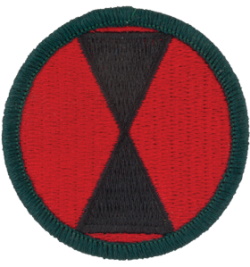 May 9–10 1945 – Back in the Line
May 9–10 1945 – Back in the Line
On May 6, Field Order # 20, (HQ 96-ID), was issued ordering all units to make plans for the relief of the 7-ID in the line, by echelon. The 382/96 was directed to move to an assembly area in the rear of the 17/7 on May 8 and to relieve them on May 9 under the control of the 7-ID. The 383/96 was directed to move to an assembly area in the rear of the 184/7 on May 9 and to relieve them on May 10. The 381/96 was directed to make a reconnaissance and to move to a reserve position on May 10 in relief of the 32/7. On May 8, the 382/96 moved 2 battalions forward to an assembly area, and on May 9, began the relief of the 17/7 at 1300. By 1700, the relief was completed. The 96-ID CP moved from Futenma to a new location situated at 8577-A at 1330, on May 8. From positions previously occupied by the 17/7, the 382-IR jumped off in the attack south at 1000 on May 10 under the control of the 7-ID until 1420, when the Commanding General, 96-ID, assumed command of the new zone of action.
During this attack, with the 1/382 on the right and the 3/382 on the left, the regiment advanced initially against light resistance on the right flank then extremely heavy resistance in the center and left flank. As the 1/382 approached the Zebra Hill 8173-Q, they encountered heavy mortar, machine gun, and rifle fire coming from the draw between the Zebra Hill and the How Hill at 8173-MN. At 1500, a coordinated assault using tanks, flamethrowers, and pole charges, began on the draw. This strong point was finally reduced after numerous casualties had been received. Finally, Zebra and the Item were both secured. On May 9, the 383-IR moved to a new forward assembly area in the preparation for the relief of the 184/7-ID. On May 10, the 2/383 completed the relief of the 3/184 at 0930, and at 1200, the 1/383 completed the relief of the 1/184. By 1300, the assault elements of 383-IR were in position and had assumed all responsibilities of the 184-IR zone.
 After this relief, the 1/383 sent out 4 strong recon patrols to the front in the vicinity of the Easy Hill (8172-03), and by 1700, had advanced elements forward to occupy this hill. The 381-IR (Division Reserve) closed into the forward assembly positions by 1300 and assumed all responsibilities of the 32-IR zone. The 96-Recon relieved the 7-Recon at 1300 and occupied positions 100 yards north east of the Yonabaru Airfield. As a result of these activities, the 96-ID completed the relief of the 7-ID and continued to attack south in a new zone of action securing four important hills in the preparation for the 10-A coordinated attack southward planned for May 11 at 0700, an operation whose objective was to envelop and reduce the Shuri Position.
After this relief, the 1/383 sent out 4 strong recon patrols to the front in the vicinity of the Easy Hill (8172-03), and by 1700, had advanced elements forward to occupy this hill. The 381-IR (Division Reserve) closed into the forward assembly positions by 1300 and assumed all responsibilities of the 32-IR zone. The 96-Recon relieved the 7-Recon at 1300 and occupied positions 100 yards north east of the Yonabaru Airfield. As a result of these activities, the 96-ID completed the relief of the 7-ID and continued to attack south in a new zone of action securing four important hills in the preparation for the 10-A coordinated attack southward planned for May 11 at 0700, an operation whose objective was to envelop and reduce the Shuri Position.
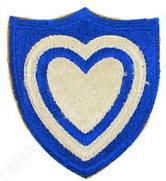 May 10, 1945 – The 96-ID Prepares for Offensive
May 10, 1945 – The 96-ID Prepares for Offensive
On May 9, Field Order # 50 (HQ XXIV Corps) ordered the 96-ID (Reinforced) to attack with its main effort initially on the right; seize the high ground east of Shuri within its zone of action; then move from the northwest and west to capture the Conical Hill northwest of Yonabaru and continue the attack to capture that portion of the Corps objective within its zone of action. On May 10, Field Order # 21 (HQ 96-ID) was issued ordering the 382-IR from positions held on May 10-11, to attack in its assigned zone making the main effort on the right, to seize the hill mass at (8072-RW) and Queen Hill (8171-P), and continue the attack to the Corps objective. The 383-IR, from positions held on May 10-11, was ordered to attack in its assigned zone, making the main effort from the northwest, right, to seize the Conical Hill (8271-KLM), and continue the attack to the Corps objective. The 381-IR, (Division Reserve) was ordered to be prepared to support the advance of either regiment and patrol from the rear of the reserve battalions to a line between (8777-Q) and (8578-G), within the division zone of action.
May 11, 1945 – Drive for the Conical Hill
On May 11, after a 30-minute artillery preparation by all the battalions of the Division Artillery, the 96-ID began the attack at 0700 toward the Corps objective and immediately met stubborn resistance across the entire front. The 1/3B2 on the Division right was engaged in a firefight with the enemy beginning at daylight. This firefight was a continuation of a counter-attack that had taken place at 2200, May 10, as an estimated company of Japs assaulted the crest of the Zebra Hill. The attack was repulsed after heavy close-in fighting. At 0730, 1/382 was still engaged in the firefight with the Japs who were defending the south slopes of the hill making it impossible for the battalion to advance over the crest. Artillery was placed on the south slopes of the hill and by 0930, elements of the battalion reinforced by tanks were advancing slowly around the right flank. By 1050, these elements had advanced 400 yards to reach the saddle at (8073-Y1-2). At 1200, the remainder of the battalion made a coordinated attack down the exposed south slopes of the hill, and by 1600 leading elements had pushed forward as far as the base of the Dick Hill (8072-D), against murderous machine-gun crossfire coming from the front and both flanks of their position. At 1630, these elements were still tenaciously hanging on, but the Japs kept continuous intense mortar fire on their position making further advances up the hill impossible. The position slowly became untenable as a supply of ammunition and evacuation of wounded became critical. It was necessary to put the seriously wounded in tanks to evacuate them across the valley floor as these elements were forced to withdraw and consolidate back in the battalion lines for the night on the south slopes of the hill at (8173-U5-V5).
The 3/382 on the regimental left flank, advanced slowly forward against heavy fire from their front and both flanks. Numerous caves and pillboxes were encountered on the south and west slopes of the Item Hill necessitating reduction one by one. Tanks were brought up but were unable to operate effectively because of swampy ground and numerous minefields. Throughout the day enemy fire was received from the west slopes of Easy Hill and William Hill (8172-E4). At the close of the period, the 3/382 had made only slight gains and occupied positions on the south slopes of the Item Hill at (8173-R3) to (8173-X2), and were in physical contact with 1/382.
The 383-IR began their attack with the 1/383 on the right and the 2/383 on the left. The advance of 1/383 was opposed by extremely stubborn resistance throughout the day. Little progress was made during the morning hut at 1200, this battalion renewed their attack on Charlie Hill at (8172-X2) and Fox Hill at (8172-R4), and by 1715 had succeeded in reaching these two hills where positions were consolidated for the night. Meeting only moderate resistance, advance elements of 2/383 moved into the town of Yonagusuku (8272-X) at 0800. From this point on heavy enemy mortar and machine-gun fire from the front along the north slopes of the Conical Hill, the eastern slopes of Charlie Hill, and the south edge of the town of Kibara (8272-PQR), limited further advances. The 2/383 then side-slipped to the right to occupy the east slopes of the King Hill (8171-E), at 1800. As a result of these activities, the 382-IR gained 200 yards on the division right flank while in the center of the division zone, the 383-IR pushed forward over 600 yards and occupied two key hills (Fox and Charlie) and the east slopes of King.
 (Above) Marine M-114 155-MM HOW of III Amphibious Corps fires in support of 10-A advance. On May 9, 1945, US Army Gen Simon Bolivar Buckner ordered a coordinated 10-A attack for May 11. The plan of attack called for the 10-A to renew the assault on the Shuri Defenses with its two corps abreast, III Amphibious Corps on the right, XXIV Corps on the left. The initial scheme of maneuver was an envelopment of Shuri by the Marine divisions on the west and the Army divisions on the east, while a strong holding attack was maintained in the center.
(Above) Marine M-114 155-MM HOW of III Amphibious Corps fires in support of 10-A advance. On May 9, 1945, US Army Gen Simon Bolivar Buckner ordered a coordinated 10-A attack for May 11. The plan of attack called for the 10-A to renew the assault on the Shuri Defenses with its two corps abreast, III Amphibious Corps on the right, XXIV Corps on the left. The initial scheme of maneuver was an envelopment of Shuri by the Marine divisions on the west and the Army divisions on the east, while a strong holding attack was maintained in the center.
The 10-A staff believed that the Japanese positions were weaker on the right and that the fresh Marine divisions had a chance for a quick breakthrough on that flank. Moreover, the terrain was more favorable along the western coast. The wide flanking maneuver around Shuri that was later developed was not projected in the original plans. Gen Buckner explained on May 10 that there would be nothing spectacular. He added: It will be a continuation of the type of attack we have been employing to date. Where we cannot take strong points we will pinch them off and leave them for the reserves to reduce. We have ample firepower and we also have enough fresh troops so that we can always have one division resting. The initial order for the attack provided for a 30-minute general preparation by the artillery just before the ground attack. This provision was revoked two days later in favor of the pinpointing of targets. The new order stated that the maximum practicable number of known enemy guns and strong points will be destroyed or neutralized prior to the infantry assault. The attack launched on schedule, although coordinated initially along the entire front, soon broke down into a series of intense battles for particular landmarks. For ten days of continuous fighting, from Sugar Loaf on the west coast to Conical Hill on the east, the Japanese, except for local and relatively minor retreats, held tenaciously to their long-prepared positions. Finally, on May 21, after some of the fiercest action of the battle of Okinawa, the American forces were to seize the eastern slope of Conical Hill, close to the east coast, and thereby to make an opening in the enemy lines which permitted an attempt at envelopment.
(Bellow) M-4A3 Sherman of the 706-TB attached to the US 77-ID (10-A), stuck crossing a 5-foot stream. Other Shermans are behind it. Both the Americans and the Japanese could not maneuver in a constant torrential downpour known locally as the Plum Rains. The tank commander looks on as the driver bales the tank out. Note ‘Pop’ written on the driver’s helmet. The tank would have to wait until a tractor could be available to pull it out. The 706-TB fought at Guam, Leyte, Ie Shima, Okinawa, and was back at Luzon in the Philippines at the end of the war.













